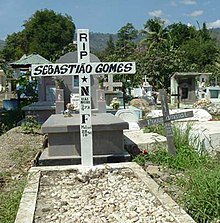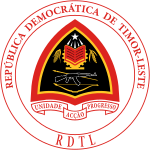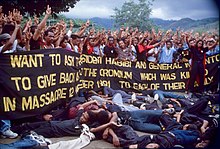Santa Cruz massacre
| Santa Cruz massacre | |
|---|---|
| Part of the East Timor genocide during the Indonesian occupation of East Timor | |
 The Santa Cruz massacre took place during a 1991 funeral procession to the grave of Sebastião Gomes. | |
| Location | Santa Cruz cemetery, Dili |
| Coordinates | 08°33′47″S 125°35′12″E / 8.56306°S 125.58667°E |
| Date | 12 November 1991 (UTC+9) |
| Target | East Timorese |
Attack type | Massacre |
| Deaths | 250+ |
| Perpetrators | Indonesian Army |
| History of East Timor |
|---|
 |
| Chronology |
|
| Topics |
|
|
The Santa Cruz massacre (also known as the Dili massacre) was the murder of at least 250 East Timorese pro-independence demonstrators in the Santa Cruz cemetery in the capital, Dili, on 12 November 1991, during the Indonesian occupation of East Timor and is part of the East Timor genocide.
Background
In October 1991, a delegation to East Timor consisting of members of the
Foreigners who had come to East Timor to observe the Portuguese delegation included independent US journalists Amy Goodman and Allan Nairn, and British cameraman Max Stahl. They attended a memorial service for Gomes on 12 November, during which several thousand men, women, and children walked from the Motael Church to the nearby Santa Cruz cemetery. Along the way, members of the group pulled out banners and East Timorese flags.[6] Organizers of the protest maintained order during the protest; although it was loud, the crowd was peaceful and orderly, by most accounts.[7] It was the largest and most visible demonstration against the Indonesian occupation since 1975.[8]
The massacre
During a brief confrontation between Indonesian troops and protesters, some protesters and a major, Geerhan Lantara were stabbed.[9] Stahl claimed Lantara had attacked a group of protesters including a girl carrying the flag of East Timor, and FRETILIN activist Constâncio Pinto reported witness accounts of beatings from Indonesian soldiers and police.[10][11] When the procession entered the cemetery some continued their protests before the cemetery wall. Around 200 more Indonesian soldiers arrived and advanced on the gathering, weapons drawn.[12] In the graveyard, they opened fire on hundreds of unarmed civilians. At least 250 East Timorese were killed in the massacre.[13] One of the dead was a New Zealander, Kamal Bamadhaj, a political science student and human rights activist based in Australia.
The
Indonesian authorities described the incident as a spontaneous reaction to violence from the protesters or a "misunderstanding".
Aftermath

In response to the massacre, activists around the world organised in solidarity with the East Timorese. Although a small network of individuals and groups had been working for human rights and self-determination in East Timor since the occupation began, their activity took on a new urgency after the 1991 massacre.[23] TAPOL, a British organisation formed in 1973 to advocate for democracy in Indonesia, increased its work around East Timor. In the United States, the East Timor Action Network was founded and soon had chapters in ten cities around the country.[24] Other solidarity groups appeared in Portugal, Australia, Japan, Germany, Malaysia, Ireland, and Brazil.
The television pictures of the massacre were shown worldwide, causing the Indonesian government considerable embarrassment. The coverage was a vivid example of how growth of new media in Indonesia was making it increasingly difficult for the "New Order" to control information flow in and out of Indonesia, and that in the post-Cold War 1990s, the government was coming under increasing international scrutiny. Copies of the Santa Cruz footage were distributed back into Indonesia allowing more Indonesians to see the actions of their government uncensored.[25] A number of pro-democracy student groups and their magazines began to openly and critically discuss not just East Timor, but also the "New Order" and the broader history and future of Indonesia.[23][25][26]
The
The massacre prompted the
In Australia, there was criticism of the federal government's recognition of Jakarta's sovereignty over East Timor. The government had been promoting increased ties with the Indonesian military at the time of the massacre, but in 1999 temporarily cut off military ties in response to the violence after that year's independence referendum.[33] Australian foreign minister Gareth Evans described the killings as "an aberration, not an act of state policy".[34]
Commemorated as a public holiday in now independent East Timor, 12 November is remembered by the East Timorese as one of the bloodiest days in their history, one which drew worldwide attention to their fight for independence.
See also
Notes
- ^ Krieger, p. 257.
- ^ Alatas, p. 53.
- ^ Hyland, Tom: "Jakarta 'sabotage Timor visit'" Archived 17 September 2006 at the Wayback Machine, The Age, 28 October 1991. Read at Hamline University Apakabar Site. URL Accessed 26 August 2006.
- ^ Pinto, p. 183; Alatas, p. 57.
- ^ Singh, pp. 155–156; Pinto, pp. 183–184; Carey, p. 49; Alatas, p. 57. Alatas and Singh do not mention the presence of Indonesian troops at the church. Carey describes Henriques as "a Timorese member of a ninja (masked killer) unit which had broken into the Motael Church ... to harass the sheltering students". Pinto describes him as "working for Indonesian intelligence".
- ^ Carey, p. 50; Jardine, p. 15; Alatas, p. 58.
- ^ Anderson, p. 146; Carey, p. 50; Singh, p. 157; Alatas, pp. 57–58; Amnesty (1991), p. 1. Alatas describes a peaceful procession "taken over by a small group of agitators", whose provocations included "the display of FRETILIN flags and banners" and "the shouting of anti-integration slogans".
- ^ Pinto and Jardine, p. 190.
- ^ Krieger, pp. 257–258.
- ^ Kubiak, W. David. "20 Years of Terror: Indonesia in Timor – An Angry Education with Max Stahl". Kyoto Journal. 28. Reprinted at The Forum of Democratic Leaders in the Asia-Pacific. Retrieved on 14 February 2008.
- ^ Pinto and Jardine, p. 191.
- ^ Carey, p. 50; Pinto and Jardine, p. 191; Anderson, pp. 149–150; Alatas, p. 58; Singh, pp. 157–159. Pinto insisted that "there was no provocation", while Anderson discussed in detail the lack of warning shots. Amnesty International (1991) confirmed these claims via eyewitness testimony.
- ^ Carey, p. 51; Jardine, p. 16. The Portuguese solidarity group A Paz é Possível em Timor Leste compiled a careful survey of the massacre's victims, listing 271 killed, 278 wounded, and 270 "disappeared".
- Democracy Now, 28 January 2008. Retrieved on February 14, 2008.
- ^ "Amy Goodman speaks with Jeremy Scahill on "Intercepted"". The Intercept. Retrieved 7 August 2019.
- ^ "FIRST TUESDAY (COLD BLOOD: THE MASSACRE OF EAST TIMOR)". ITN (Independent Television News). Archived from the original on 19 October 2013. Retrieved 9 January 2013.
- ^ Jardine, pp. 16–17; Carey, pp. 52–53.
- ^ "'Cold Blood' AI Winner" (Press release). Reuters. 4 June 1992. Archived from the original on 19 October 2013. Retrieved 9 January 2013.
- ISBN 978-0-89608-541-1.
- ^ Brigadier General Warouw in Amnesty (1991), p. 4
- ^ Carey, p. 51.
- ^ Quoted in Carey, p. 52. A slightly different wording ("...and we will shoot them") is quoted in Jardine, p. 17.
- ^ a b Jardine, pp. 67–69.
- ^ "About ETAN". East Timor Action Network. Retrieved on 18 February 2008.
- ^ a b Vickers (2005), pp. 200–201
- ^ CIIR, pp. 62–63; Dunn, p. 311.
- ^ ETAN: U.S. Policy toward East Timor, East Timor and Indonesia Action Network.
- ^ ETAN Backgrounder for May 20 Independence, East Timor and Indonesia Action Network.
- ^ ETAN. "Senator Leahy on Military Aid to Indonesia and East Timor". East Timor and Indonesia Action Network. Retrieved 6 April 2013.
- ^ UPI. "Indonesia gets $1.56B in U.S. military aid". World News. United Press International. Retrieved 6 April 2013.
- ^ Los Angeles Times. "U.S. to resume aid to Kopassus Indonesia's controversial military forces". LA Times. Los Angeles Times. Retrieved 6 April 2013.
- ^ "CAAT Publications – Arms to Indonesia Factsheet". Archived from the original on 17 September 2008. Retrieved 12 July 2008.
- ^ "Australia should avoid ties with Indonesia military: Study". Reuters. Retrieved on 16 August 2007.
- ^ The Specter of Genocide: Mass Murder in Historical Perspective, Robert Gellately, Ben Kiernan, Cambridge University Press, 2003, page 179
References
- Carey, Peter. "Historical Background". Generations of Resistance. By Steve Cox. London: Cassell, 1995. ISBN 0-304-33252-6. pp. 13–55.
- Comissão de Acolhimento, Verdade e Reconciliação de Timor Leste (CAVR). Chega! The Report of the Commission for Reception, Truth and Reconciliation. Dili, East Timor: 2005. Online at East Timor & Indonesia Action Network. Retrieved on 11 February 2008.
- Hearman, Vannessa; Loney, Hannah; Ramos Gonçalves, Marisa; Leach, Michael, eds. (2023). The Santa Cruz Massacre, 1991: Thirty Years On. Proceedings of an International Research Symposium. Hawthorn, Vic: Swinburne University of Technology.
- Jardine, Matthew. East Timor: Genocide in Paradise. Monroe, ME: Odonian Press, 1999. ISBN 1-878825-22-4.
- Krieger, Heike, ed. East Timor and the International Community: Basic Documents. Melbourne: Cambridge University Press, 1997. ISBN 0-521-58134-6.
- Pinto, Constancio (1997). East Timor's Unfinished Struggle: Inside the Timorese Resistance. Boston: ISBN 0-89608-542-2.
- Vickers, Adrian (2005). A History of Modern Indonesia. Cambridge University Press. ISBN 0-521-54262-6.
External links
- Massacre: The Story of East Timor Archived 14 November 2007 at the Wayback Machine
- ETAN on the massacre
- IFET on the massacre
- Max Stahl Interview
- Video: Re-enactment of the Massacre on the Ninth Anniversary Santa Cruz Massacre Archived 26 February 2009 at the Wayback Machine
- East Timorese Journalist Marks 19th Anniversary of Santa Cruz Massacre – video report by Democracy Now!

